Nutrition Assessment Report: Triathlete Dietary Plan and Analysis
VerifiedAdded on 2021/04/20
|21
|7475
|103
Report
AI Summary
This report provides a detailed nutrition assessment of a 25-year-old triathlete, Mark, who is physically active and races frequently. The assessment begins with an overview of Mark's physical characteristics, estimated energy requirements, and the importance of dietary requirements based on New Zealand guidelines. It highlights the need for a balanced diet with plenty of vegetables, fruits, whole grains, and lean proteins, while limiting processed foods, added sugars, and unhealthy fats. The report emphasizes the triathlete's increased needs for electrolytes and the importance of adequate protein intake for tissue repair. A 24-hour dietary plan is provided, detailing a balanced meal plan with specific calorie and carbohydrate targets for breakfast, snacks, lunch, and dinner, with an emphasis on incorporating nutrient-rich foods from all food groups to support the athlete's performance and overall health. The plan includes specific food choices and portion sizes, such as yogurt, fruits, whole-wheat bread, lean proteins, vegetables, and healthy fats, to meet the triathlete's energy and nutrient needs.
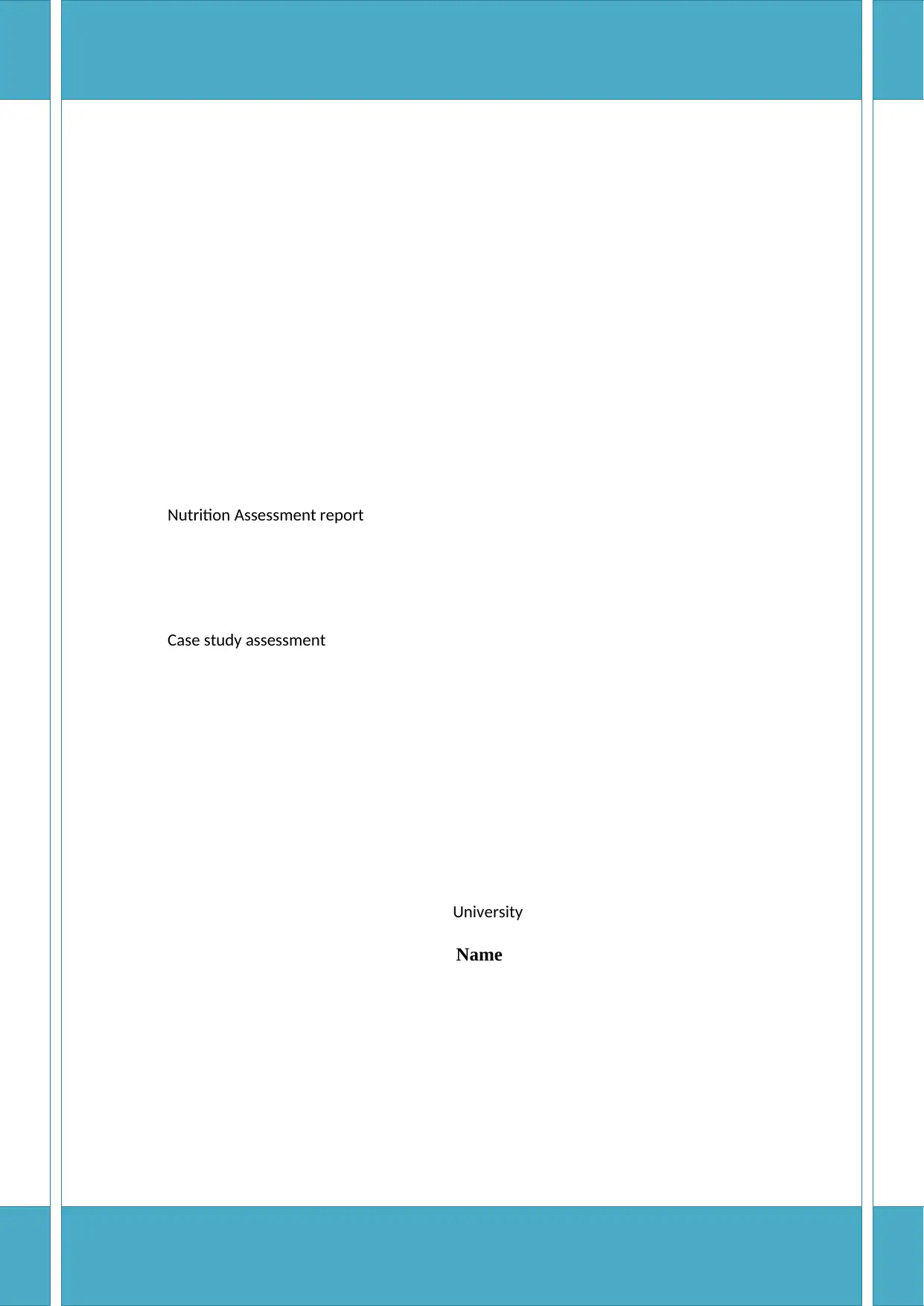
Nutrition Assessment report
Case study assessment
University
Name
Case study assessment
University
Name
Paraphrase This Document
Need a fresh take? Get an instant paraphrase of this document with our AI Paraphraser
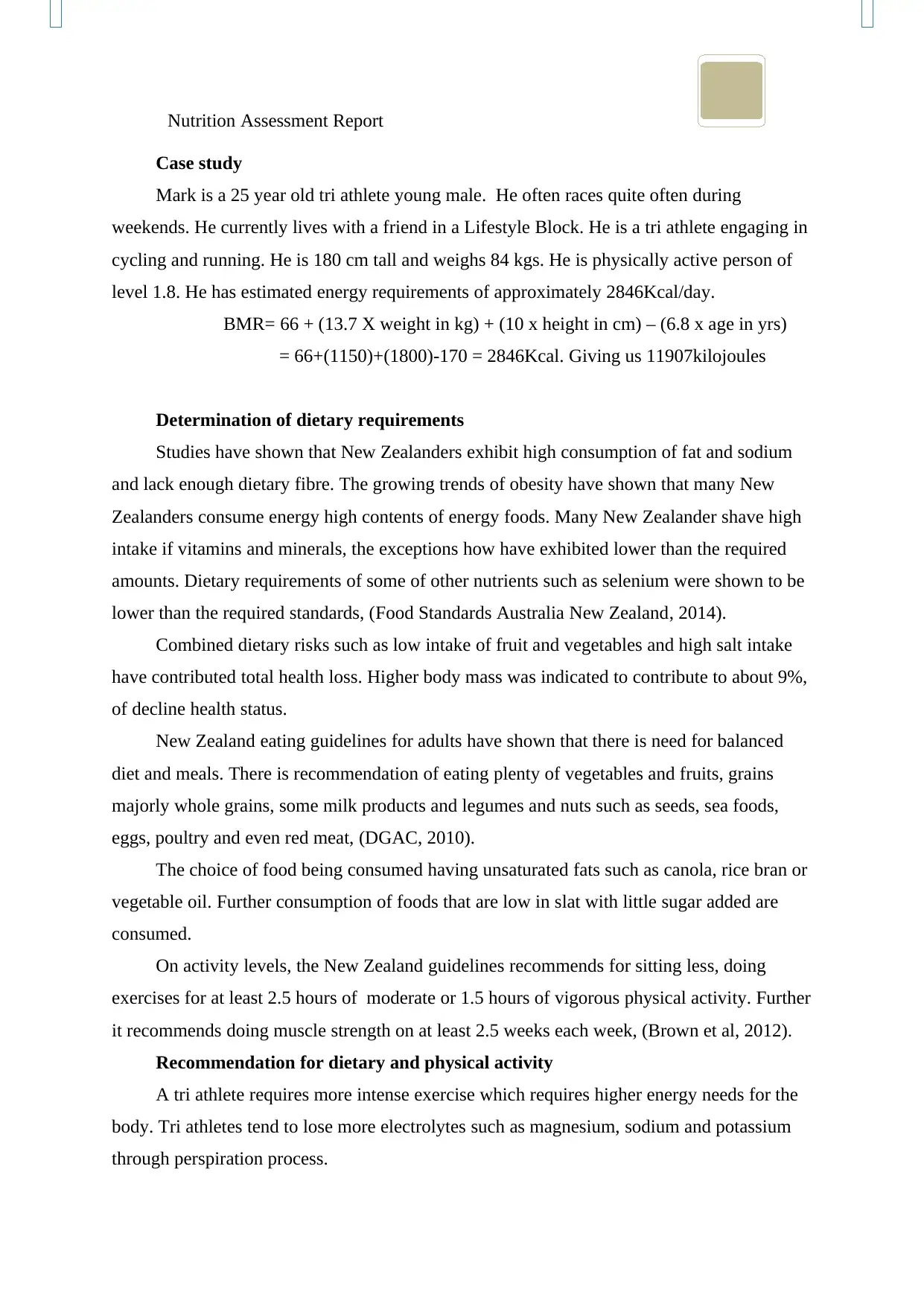
Nutrition Assessment Report
Case study
Mark is a 25 year old tri athlete young male. He often races quite often during
weekends. He currently lives with a friend in a Lifestyle Block. He is a tri athlete engaging in
cycling and running. He is 180 cm tall and weighs 84 kgs. He is physically active person of
level 1.8. He has estimated energy requirements of approximately 2846Kcal/day.
BMR= 66 + (13.7 X weight in kg) + (10 x height in cm) – (6.8 x age in yrs)
= 66+(1150)+(1800)-170 = 2846Kcal. Giving us 11907kilojoules
Determination of dietary requirements
Studies have shown that New Zealanders exhibit high consumption of fat and sodium
and lack enough dietary fibre. The growing trends of obesity have shown that many New
Zealanders consume energy high contents of energy foods. Many New Zealander shave high
intake if vitamins and minerals, the exceptions how have exhibited lower than the required
amounts. Dietary requirements of some of other nutrients such as selenium were shown to be
lower than the required standards, (Food Standards Australia New Zealand, 2014).
Combined dietary risks such as low intake of fruit and vegetables and high salt intake
have contributed total health loss. Higher body mass was indicated to contribute to about 9%,
of decline health status.
New Zealand eating guidelines for adults have shown that there is need for balanced
diet and meals. There is recommendation of eating plenty of vegetables and fruits, grains
majorly whole grains, some milk products and legumes and nuts such as seeds, sea foods,
eggs, poultry and even red meat, (DGAC, 2010).
The choice of food being consumed having unsaturated fats such as canola, rice bran or
vegetable oil. Further consumption of foods that are low in slat with little sugar added are
consumed.
On activity levels, the New Zealand guidelines recommends for sitting less, doing
exercises for at least 2.5 hours of moderate or 1.5 hours of vigorous physical activity. Further
it recommends doing muscle strength on at least 2.5 weeks each week, (Brown et al, 2012).
Recommendation for dietary and physical activity
A tri athlete requires more intense exercise which requires higher energy needs for the
body. Tri athletes tend to lose more electrolytes such as magnesium, sodium and potassium
through perspiration process.
Case study
Mark is a 25 year old tri athlete young male. He often races quite often during
weekends. He currently lives with a friend in a Lifestyle Block. He is a tri athlete engaging in
cycling and running. He is 180 cm tall and weighs 84 kgs. He is physically active person of
level 1.8. He has estimated energy requirements of approximately 2846Kcal/day.
BMR= 66 + (13.7 X weight in kg) + (10 x height in cm) – (6.8 x age in yrs)
= 66+(1150)+(1800)-170 = 2846Kcal. Giving us 11907kilojoules
Determination of dietary requirements
Studies have shown that New Zealanders exhibit high consumption of fat and sodium
and lack enough dietary fibre. The growing trends of obesity have shown that many New
Zealanders consume energy high contents of energy foods. Many New Zealander shave high
intake if vitamins and minerals, the exceptions how have exhibited lower than the required
amounts. Dietary requirements of some of other nutrients such as selenium were shown to be
lower than the required standards, (Food Standards Australia New Zealand, 2014).
Combined dietary risks such as low intake of fruit and vegetables and high salt intake
have contributed total health loss. Higher body mass was indicated to contribute to about 9%,
of decline health status.
New Zealand eating guidelines for adults have shown that there is need for balanced
diet and meals. There is recommendation of eating plenty of vegetables and fruits, grains
majorly whole grains, some milk products and legumes and nuts such as seeds, sea foods,
eggs, poultry and even red meat, (DGAC, 2010).
The choice of food being consumed having unsaturated fats such as canola, rice bran or
vegetable oil. Further consumption of foods that are low in slat with little sugar added are
consumed.
On activity levels, the New Zealand guidelines recommends for sitting less, doing
exercises for at least 2.5 hours of moderate or 1.5 hours of vigorous physical activity. Further
it recommends doing muscle strength on at least 2.5 weeks each week, (Brown et al, 2012).
Recommendation for dietary and physical activity
A tri athlete requires more intense exercise which requires higher energy needs for the
body. Tri athletes tend to lose more electrolytes such as magnesium, sodium and potassium
through perspiration process.
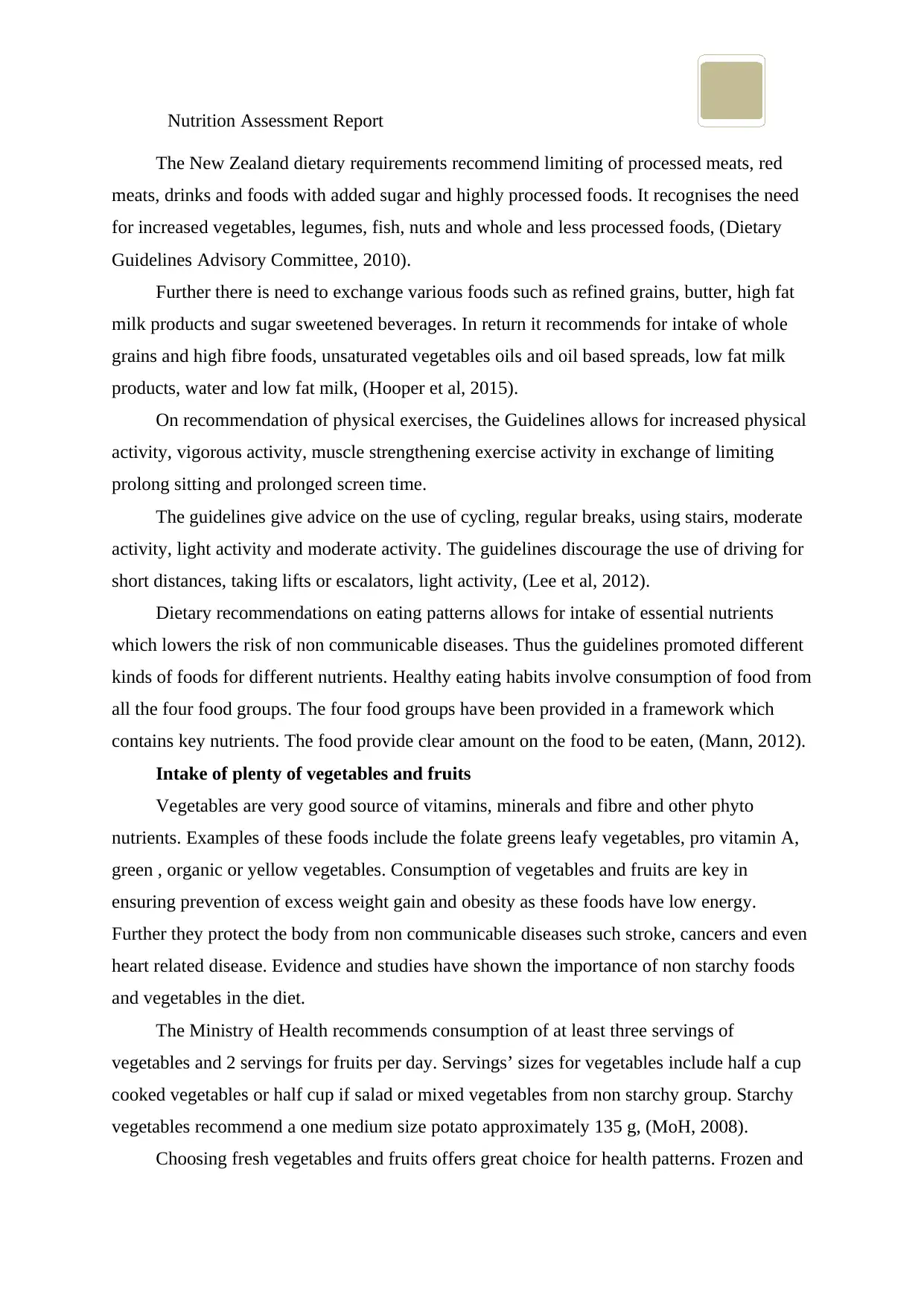
Nutrition Assessment Report
The New Zealand dietary requirements recommend limiting of processed meats, red
meats, drinks and foods with added sugar and highly processed foods. It recognises the need
for increased vegetables, legumes, fish, nuts and whole and less processed foods, (Dietary
Guidelines Advisory Committee, 2010).
Further there is need to exchange various foods such as refined grains, butter, high fat
milk products and sugar sweetened beverages. In return it recommends for intake of whole
grains and high fibre foods, unsaturated vegetables oils and oil based spreads, low fat milk
products, water and low fat milk, (Hooper et al, 2015).
On recommendation of physical exercises, the Guidelines allows for increased physical
activity, vigorous activity, muscle strengthening exercise activity in exchange of limiting
prolong sitting and prolonged screen time.
The guidelines give advice on the use of cycling, regular breaks, using stairs, moderate
activity, light activity and moderate activity. The guidelines discourage the use of driving for
short distances, taking lifts or escalators, light activity, (Lee et al, 2012).
Dietary recommendations on eating patterns allows for intake of essential nutrients
which lowers the risk of non communicable diseases. Thus the guidelines promoted different
kinds of foods for different nutrients. Healthy eating habits involve consumption of food from
all the four food groups. The four food groups have been provided in a framework which
contains key nutrients. The food provide clear amount on the food to be eaten, (Mann, 2012).
Intake of plenty of vegetables and fruits
Vegetables are very good source of vitamins, minerals and fibre and other phyto
nutrients. Examples of these foods include the folate greens leafy vegetables, pro vitamin A,
green , organic or yellow vegetables. Consumption of vegetables and fruits are key in
ensuring prevention of excess weight gain and obesity as these foods have low energy.
Further they protect the body from non communicable diseases such stroke, cancers and even
heart related disease. Evidence and studies have shown the importance of non starchy foods
and vegetables in the diet.
The Ministry of Health recommends consumption of at least three servings of
vegetables and 2 servings for fruits per day. Servings’ sizes for vegetables include half a cup
cooked vegetables or half cup if salad or mixed vegetables from non starchy group. Starchy
vegetables recommend a one medium size potato approximately 135 g, (MoH, 2008).
Choosing fresh vegetables and fruits offers great choice for health patterns. Frozen and
The New Zealand dietary requirements recommend limiting of processed meats, red
meats, drinks and foods with added sugar and highly processed foods. It recognises the need
for increased vegetables, legumes, fish, nuts and whole and less processed foods, (Dietary
Guidelines Advisory Committee, 2010).
Further there is need to exchange various foods such as refined grains, butter, high fat
milk products and sugar sweetened beverages. In return it recommends for intake of whole
grains and high fibre foods, unsaturated vegetables oils and oil based spreads, low fat milk
products, water and low fat milk, (Hooper et al, 2015).
On recommendation of physical exercises, the Guidelines allows for increased physical
activity, vigorous activity, muscle strengthening exercise activity in exchange of limiting
prolong sitting and prolonged screen time.
The guidelines give advice on the use of cycling, regular breaks, using stairs, moderate
activity, light activity and moderate activity. The guidelines discourage the use of driving for
short distances, taking lifts or escalators, light activity, (Lee et al, 2012).
Dietary recommendations on eating patterns allows for intake of essential nutrients
which lowers the risk of non communicable diseases. Thus the guidelines promoted different
kinds of foods for different nutrients. Healthy eating habits involve consumption of food from
all the four food groups. The four food groups have been provided in a framework which
contains key nutrients. The food provide clear amount on the food to be eaten, (Mann, 2012).
Intake of plenty of vegetables and fruits
Vegetables are very good source of vitamins, minerals and fibre and other phyto
nutrients. Examples of these foods include the folate greens leafy vegetables, pro vitamin A,
green , organic or yellow vegetables. Consumption of vegetables and fruits are key in
ensuring prevention of excess weight gain and obesity as these foods have low energy.
Further they protect the body from non communicable diseases such stroke, cancers and even
heart related disease. Evidence and studies have shown the importance of non starchy foods
and vegetables in the diet.
The Ministry of Health recommends consumption of at least three servings of
vegetables and 2 servings for fruits per day. Servings’ sizes for vegetables include half a cup
cooked vegetables or half cup if salad or mixed vegetables from non starchy group. Starchy
vegetables recommend a one medium size potato approximately 135 g, (MoH, 2008).
Choosing fresh vegetables and fruits offers great choice for health patterns. Frozen and
⊘ This is a preview!⊘
Do you want full access?
Subscribe today to unlock all pages.

Trusted by 1+ million students worldwide
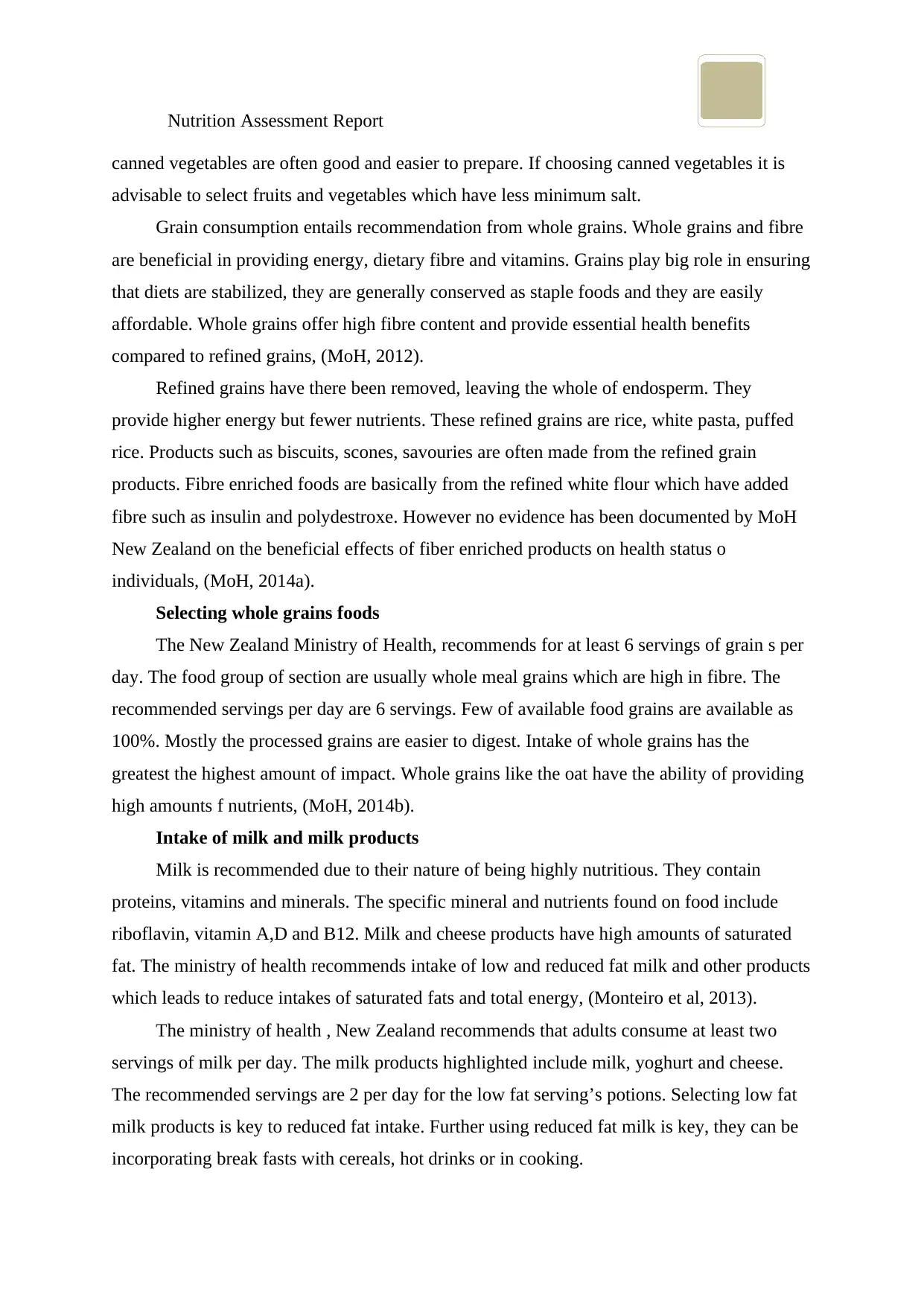
Nutrition Assessment Report
canned vegetables are often good and easier to prepare. If choosing canned vegetables it is
advisable to select fruits and vegetables which have less minimum salt.
Grain consumption entails recommendation from whole grains. Whole grains and fibre
are beneficial in providing energy, dietary fibre and vitamins. Grains play big role in ensuring
that diets are stabilized, they are generally conserved as staple foods and they are easily
affordable. Whole grains offer high fibre content and provide essential health benefits
compared to refined grains, (MoH, 2012).
Refined grains have there been removed, leaving the whole of endosperm. They
provide higher energy but fewer nutrients. These refined grains are rice, white pasta, puffed
rice. Products such as biscuits, scones, savouries are often made from the refined grain
products. Fibre enriched foods are basically from the refined white flour which have added
fibre such as insulin and polydestroxe. However no evidence has been documented by MoH
New Zealand on the beneficial effects of fiber enriched products on health status o
individuals, (MoH, 2014a).
Selecting whole grains foods
The New Zealand Ministry of Health, recommends for at least 6 servings of grain s per
day. The food group of section are usually whole meal grains which are high in fibre. The
recommended servings per day are 6 servings. Few of available food grains are available as
100%. Mostly the processed grains are easier to digest. Intake of whole grains has the
greatest the highest amount of impact. Whole grains like the oat have the ability of providing
high amounts f nutrients, (MoH, 2014b).
Intake of milk and milk products
Milk is recommended due to their nature of being highly nutritious. They contain
proteins, vitamins and minerals. The specific mineral and nutrients found on food include
riboflavin, vitamin A,D and B12. Milk and cheese products have high amounts of saturated
fat. The ministry of health recommends intake of low and reduced fat milk and other products
which leads to reduce intakes of saturated fats and total energy, (Monteiro et al, 2013).
The ministry of health , New Zealand recommends that adults consume at least two
servings of milk per day. The milk products highlighted include milk, yoghurt and cheese.
The recommended servings are 2 per day for the low fat serving’s potions. Selecting low fat
milk products is key to reduced fat intake. Further using reduced fat milk is key, they can be
incorporating break fasts with cereals, hot drinks or in cooking.
canned vegetables are often good and easier to prepare. If choosing canned vegetables it is
advisable to select fruits and vegetables which have less minimum salt.
Grain consumption entails recommendation from whole grains. Whole grains and fibre
are beneficial in providing energy, dietary fibre and vitamins. Grains play big role in ensuring
that diets are stabilized, they are generally conserved as staple foods and they are easily
affordable. Whole grains offer high fibre content and provide essential health benefits
compared to refined grains, (MoH, 2012).
Refined grains have there been removed, leaving the whole of endosperm. They
provide higher energy but fewer nutrients. These refined grains are rice, white pasta, puffed
rice. Products such as biscuits, scones, savouries are often made from the refined grain
products. Fibre enriched foods are basically from the refined white flour which have added
fibre such as insulin and polydestroxe. However no evidence has been documented by MoH
New Zealand on the beneficial effects of fiber enriched products on health status o
individuals, (MoH, 2014a).
Selecting whole grains foods
The New Zealand Ministry of Health, recommends for at least 6 servings of grain s per
day. The food group of section are usually whole meal grains which are high in fibre. The
recommended servings per day are 6 servings. Few of available food grains are available as
100%. Mostly the processed grains are easier to digest. Intake of whole grains has the
greatest the highest amount of impact. Whole grains like the oat have the ability of providing
high amounts f nutrients, (MoH, 2014b).
Intake of milk and milk products
Milk is recommended due to their nature of being highly nutritious. They contain
proteins, vitamins and minerals. The specific mineral and nutrients found on food include
riboflavin, vitamin A,D and B12. Milk and cheese products have high amounts of saturated
fat. The ministry of health recommends intake of low and reduced fat milk and other products
which leads to reduce intakes of saturated fats and total energy, (Monteiro et al, 2013).
The ministry of health , New Zealand recommends that adults consume at least two
servings of milk per day. The milk products highlighted include milk, yoghurt and cheese.
The recommended servings are 2 per day for the low fat serving’s potions. Selecting low fat
milk products is key to reduced fat intake. Further using reduced fat milk is key, they can be
incorporating break fasts with cereals, hot drinks or in cooking.
Paraphrase This Document
Need a fresh take? Get an instant paraphrase of this document with our AI Paraphraser
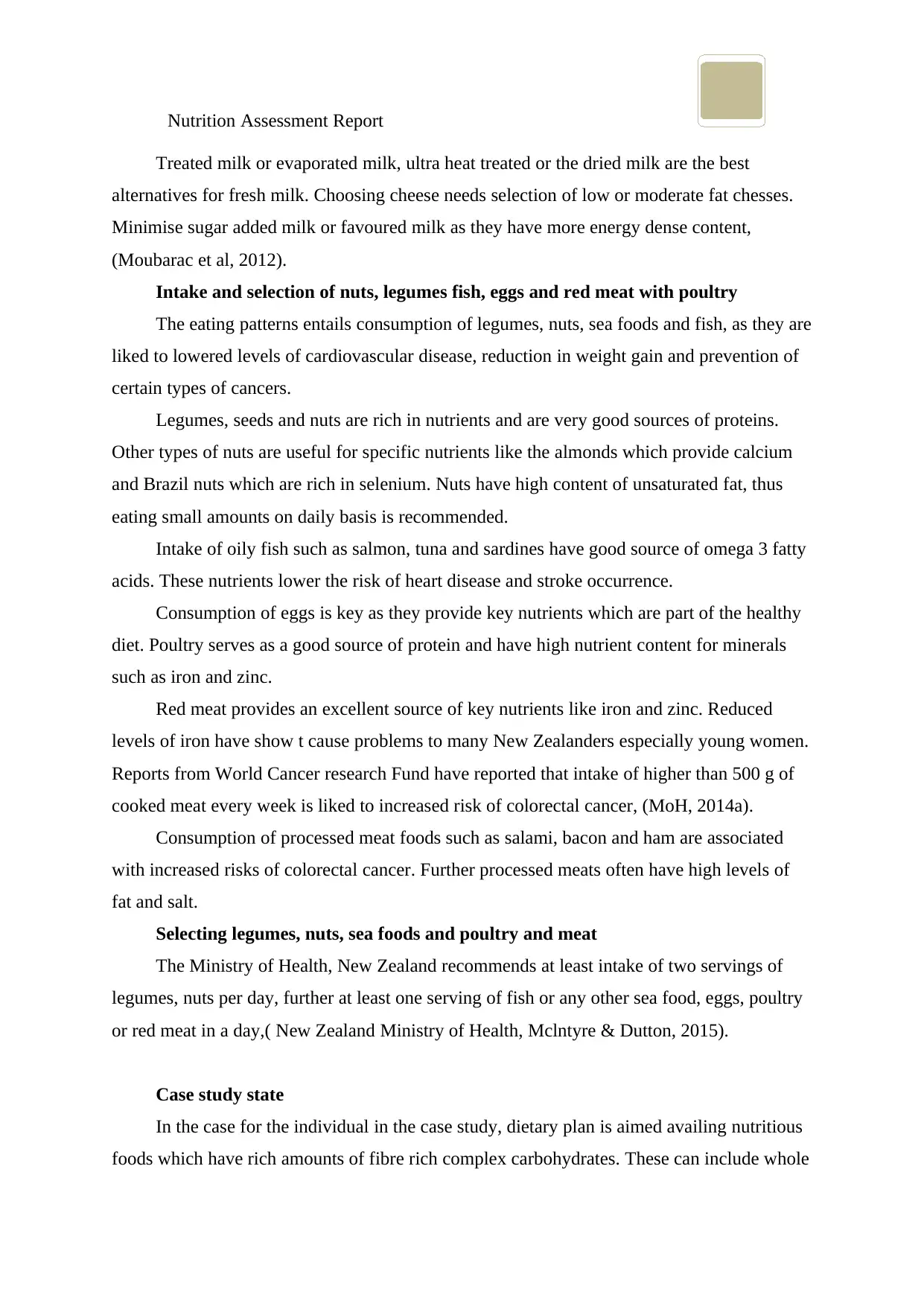
Nutrition Assessment Report
Treated milk or evaporated milk, ultra heat treated or the dried milk are the best
alternatives for fresh milk. Choosing cheese needs selection of low or moderate fat chesses.
Minimise sugar added milk or favoured milk as they have more energy dense content,
(Moubarac et al, 2012).
Intake and selection of nuts, legumes fish, eggs and red meat with poultry
The eating patterns entails consumption of legumes, nuts, sea foods and fish, as they are
liked to lowered levels of cardiovascular disease, reduction in weight gain and prevention of
certain types of cancers.
Legumes, seeds and nuts are rich in nutrients and are very good sources of proteins.
Other types of nuts are useful for specific nutrients like the almonds which provide calcium
and Brazil nuts which are rich in selenium. Nuts have high content of unsaturated fat, thus
eating small amounts on daily basis is recommended.
Intake of oily fish such as salmon, tuna and sardines have good source of omega 3 fatty
acids. These nutrients lower the risk of heart disease and stroke occurrence.
Consumption of eggs is key as they provide key nutrients which are part of the healthy
diet. Poultry serves as a good source of protein and have high nutrient content for minerals
such as iron and zinc.
Red meat provides an excellent source of key nutrients like iron and zinc. Reduced
levels of iron have show t cause problems to many New Zealanders especially young women.
Reports from World Cancer research Fund have reported that intake of higher than 500 g of
cooked meat every week is liked to increased risk of colorectal cancer, (MoH, 2014a).
Consumption of processed meat foods such as salami, bacon and ham are associated
with increased risks of colorectal cancer. Further processed meats often have high levels of
fat and salt.
Selecting legumes, nuts, sea foods and poultry and meat
The Ministry of Health, New Zealand recommends at least intake of two servings of
legumes, nuts per day, further at least one serving of fish or any other sea food, eggs, poultry
or red meat in a day,( New Zealand Ministry of Health, Mclntyre & Dutton, 2015).
Case study state
In the case for the individual in the case study, dietary plan is aimed availing nutritious
foods which have rich amounts of fibre rich complex carbohydrates. These can include whole
Treated milk or evaporated milk, ultra heat treated or the dried milk are the best
alternatives for fresh milk. Choosing cheese needs selection of low or moderate fat chesses.
Minimise sugar added milk or favoured milk as they have more energy dense content,
(Moubarac et al, 2012).
Intake and selection of nuts, legumes fish, eggs and red meat with poultry
The eating patterns entails consumption of legumes, nuts, sea foods and fish, as they are
liked to lowered levels of cardiovascular disease, reduction in weight gain and prevention of
certain types of cancers.
Legumes, seeds and nuts are rich in nutrients and are very good sources of proteins.
Other types of nuts are useful for specific nutrients like the almonds which provide calcium
and Brazil nuts which are rich in selenium. Nuts have high content of unsaturated fat, thus
eating small amounts on daily basis is recommended.
Intake of oily fish such as salmon, tuna and sardines have good source of omega 3 fatty
acids. These nutrients lower the risk of heart disease and stroke occurrence.
Consumption of eggs is key as they provide key nutrients which are part of the healthy
diet. Poultry serves as a good source of protein and have high nutrient content for minerals
such as iron and zinc.
Red meat provides an excellent source of key nutrients like iron and zinc. Reduced
levels of iron have show t cause problems to many New Zealanders especially young women.
Reports from World Cancer research Fund have reported that intake of higher than 500 g of
cooked meat every week is liked to increased risk of colorectal cancer, (MoH, 2014a).
Consumption of processed meat foods such as salami, bacon and ham are associated
with increased risks of colorectal cancer. Further processed meats often have high levels of
fat and salt.
Selecting legumes, nuts, sea foods and poultry and meat
The Ministry of Health, New Zealand recommends at least intake of two servings of
legumes, nuts per day, further at least one serving of fish or any other sea food, eggs, poultry
or red meat in a day,( New Zealand Ministry of Health, Mclntyre & Dutton, 2015).
Case study state
In the case for the individual in the case study, dietary plan is aimed availing nutritious
foods which have rich amounts of fibre rich complex carbohydrates. These can include whole
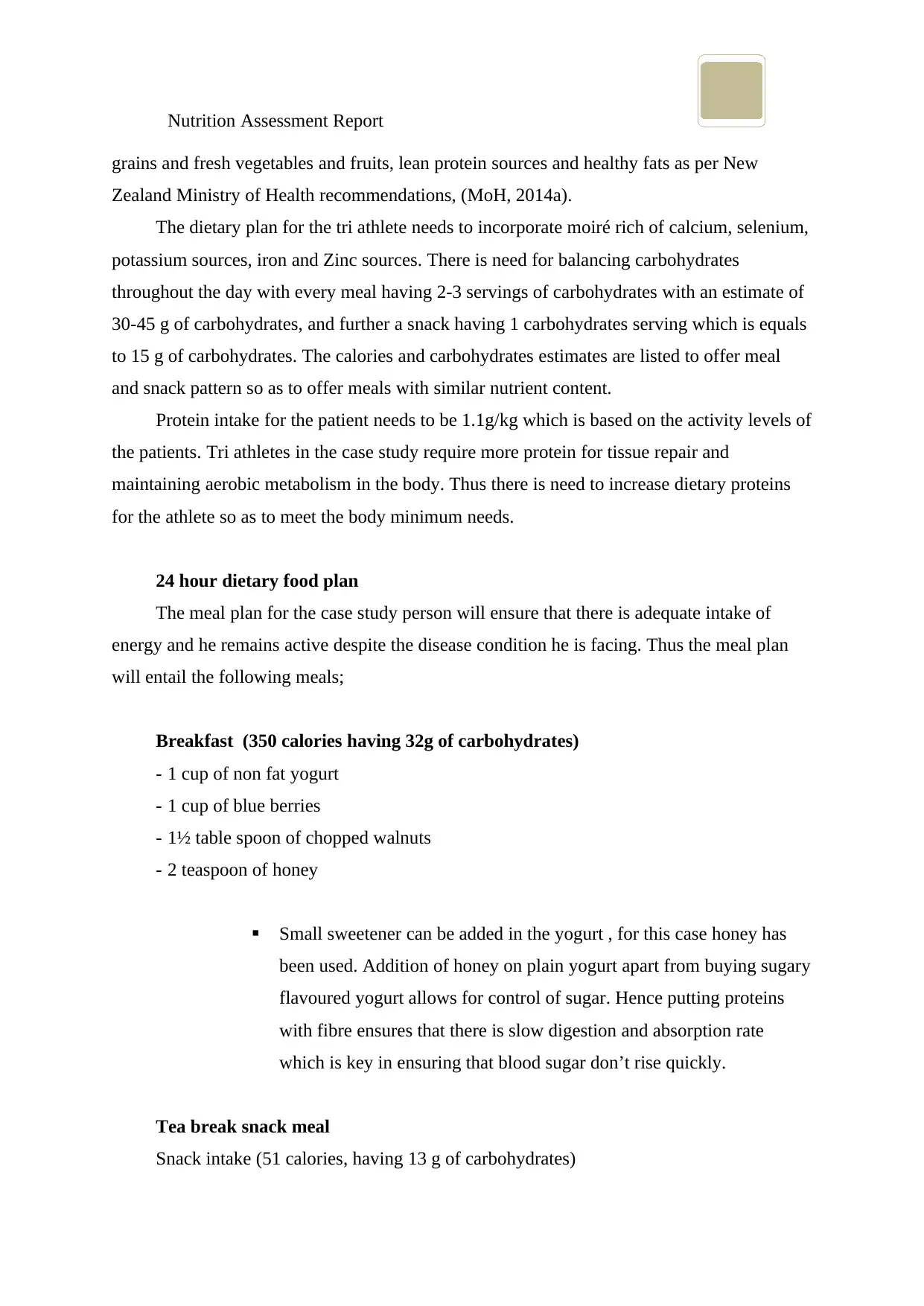
Nutrition Assessment Report
grains and fresh vegetables and fruits, lean protein sources and healthy fats as per New
Zealand Ministry of Health recommendations, (MoH, 2014a).
The dietary plan for the tri athlete needs to incorporate moiré rich of calcium, selenium,
potassium sources, iron and Zinc sources. There is need for balancing carbohydrates
throughout the day with every meal having 2-3 servings of carbohydrates with an estimate of
30-45 g of carbohydrates, and further a snack having 1 carbohydrates serving which is equals
to 15 g of carbohydrates. The calories and carbohydrates estimates are listed to offer meal
and snack pattern so as to offer meals with similar nutrient content.
Protein intake for the patient needs to be 1.1g/kg which is based on the activity levels of
the patients. Tri athletes in the case study require more protein for tissue repair and
maintaining aerobic metabolism in the body. Thus there is need to increase dietary proteins
for the athlete so as to meet the body minimum needs.
24 hour dietary food plan
The meal plan for the case study person will ensure that there is adequate intake of
energy and he remains active despite the disease condition he is facing. Thus the meal plan
will entail the following meals;
Breakfast (350 calories having 32g of carbohydrates)
- 1 cup of non fat yogurt
- 1 cup of blue berries
- 1½ table spoon of chopped walnuts
- 2 teaspoon of honey
Small sweetener can be added in the yogurt , for this case honey has
been used. Addition of honey on plain yogurt apart from buying sugary
flavoured yogurt allows for control of sugar. Hence putting proteins
with fibre ensures that there is slow digestion and absorption rate
which is key in ensuring that blood sugar don’t rise quickly.
Tea break snack meal
Snack intake (51 calories, having 13 g of carbohydrates)
grains and fresh vegetables and fruits, lean protein sources and healthy fats as per New
Zealand Ministry of Health recommendations, (MoH, 2014a).
The dietary plan for the tri athlete needs to incorporate moiré rich of calcium, selenium,
potassium sources, iron and Zinc sources. There is need for balancing carbohydrates
throughout the day with every meal having 2-3 servings of carbohydrates with an estimate of
30-45 g of carbohydrates, and further a snack having 1 carbohydrates serving which is equals
to 15 g of carbohydrates. The calories and carbohydrates estimates are listed to offer meal
and snack pattern so as to offer meals with similar nutrient content.
Protein intake for the patient needs to be 1.1g/kg which is based on the activity levels of
the patients. Tri athletes in the case study require more protein for tissue repair and
maintaining aerobic metabolism in the body. Thus there is need to increase dietary proteins
for the athlete so as to meet the body minimum needs.
24 hour dietary food plan
The meal plan for the case study person will ensure that there is adequate intake of
energy and he remains active despite the disease condition he is facing. Thus the meal plan
will entail the following meals;
Breakfast (350 calories having 32g of carbohydrates)
- 1 cup of non fat yogurt
- 1 cup of blue berries
- 1½ table spoon of chopped walnuts
- 2 teaspoon of honey
Small sweetener can be added in the yogurt , for this case honey has
been used. Addition of honey on plain yogurt apart from buying sugary
flavoured yogurt allows for control of sugar. Hence putting proteins
with fibre ensures that there is slow digestion and absorption rate
which is key in ensuring that blood sugar don’t rise quickly.
Tea break snack meal
Snack intake (51 calories, having 13 g of carbohydrates)
⊘ This is a preview!⊘
Do you want full access?
Subscribe today to unlock all pages.

Trusted by 1+ million students worldwide
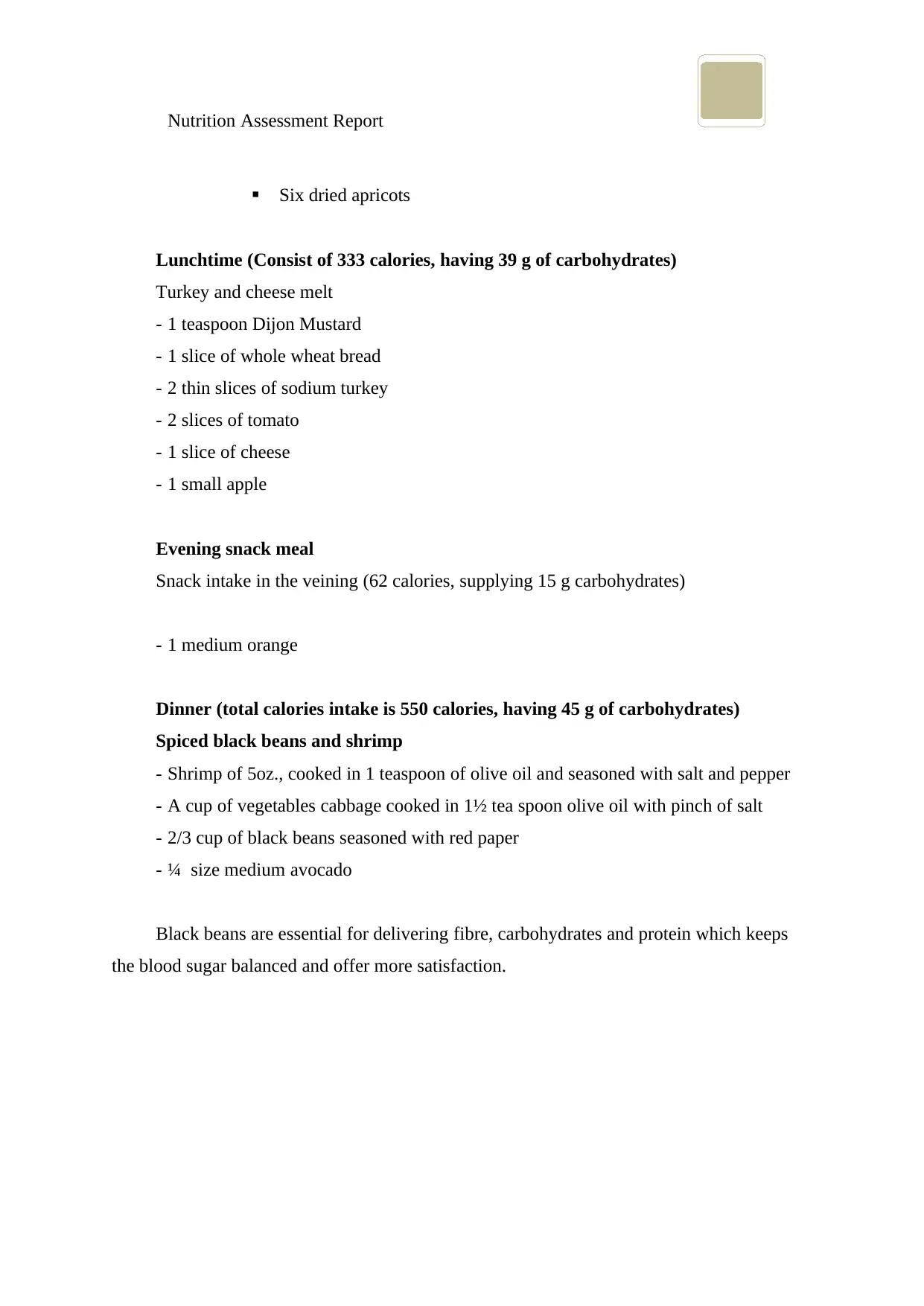
Nutrition Assessment Report
Six dried apricots
Lunchtime (Consist of 333 calories, having 39 g of carbohydrates)
Turkey and cheese melt
- 1 teaspoon Dijon Mustard
- 1 slice of whole wheat bread
- 2 thin slices of sodium turkey
- 2 slices of tomato
- 1 slice of cheese
- 1 small apple
Evening snack meal
Snack intake in the veining (62 calories, supplying 15 g carbohydrates)
- 1 medium orange
Dinner (total calories intake is 550 calories, having 45 g of carbohydrates)
Spiced black beans and shrimp
- Shrimp of 5oz., cooked in 1 teaspoon of olive oil and seasoned with salt and pepper
- A cup of vegetables cabbage cooked in 1½ tea spoon olive oil with pinch of salt
- 2/3 cup of black beans seasoned with red paper
- ¼ size medium avocado
Black beans are essential for delivering fibre, carbohydrates and protein which keeps
the blood sugar balanced and offer more satisfaction.
Six dried apricots
Lunchtime (Consist of 333 calories, having 39 g of carbohydrates)
Turkey and cheese melt
- 1 teaspoon Dijon Mustard
- 1 slice of whole wheat bread
- 2 thin slices of sodium turkey
- 2 slices of tomato
- 1 slice of cheese
- 1 small apple
Evening snack meal
Snack intake in the veining (62 calories, supplying 15 g carbohydrates)
- 1 medium orange
Dinner (total calories intake is 550 calories, having 45 g of carbohydrates)
Spiced black beans and shrimp
- Shrimp of 5oz., cooked in 1 teaspoon of olive oil and seasoned with salt and pepper
- A cup of vegetables cabbage cooked in 1½ tea spoon olive oil with pinch of salt
- 2/3 cup of black beans seasoned with red paper
- ¼ size medium avocado
Black beans are essential for delivering fibre, carbohydrates and protein which keeps
the blood sugar balanced and offer more satisfaction.
Paraphrase This Document
Need a fresh take? Get an instant paraphrase of this document with our AI Paraphraser
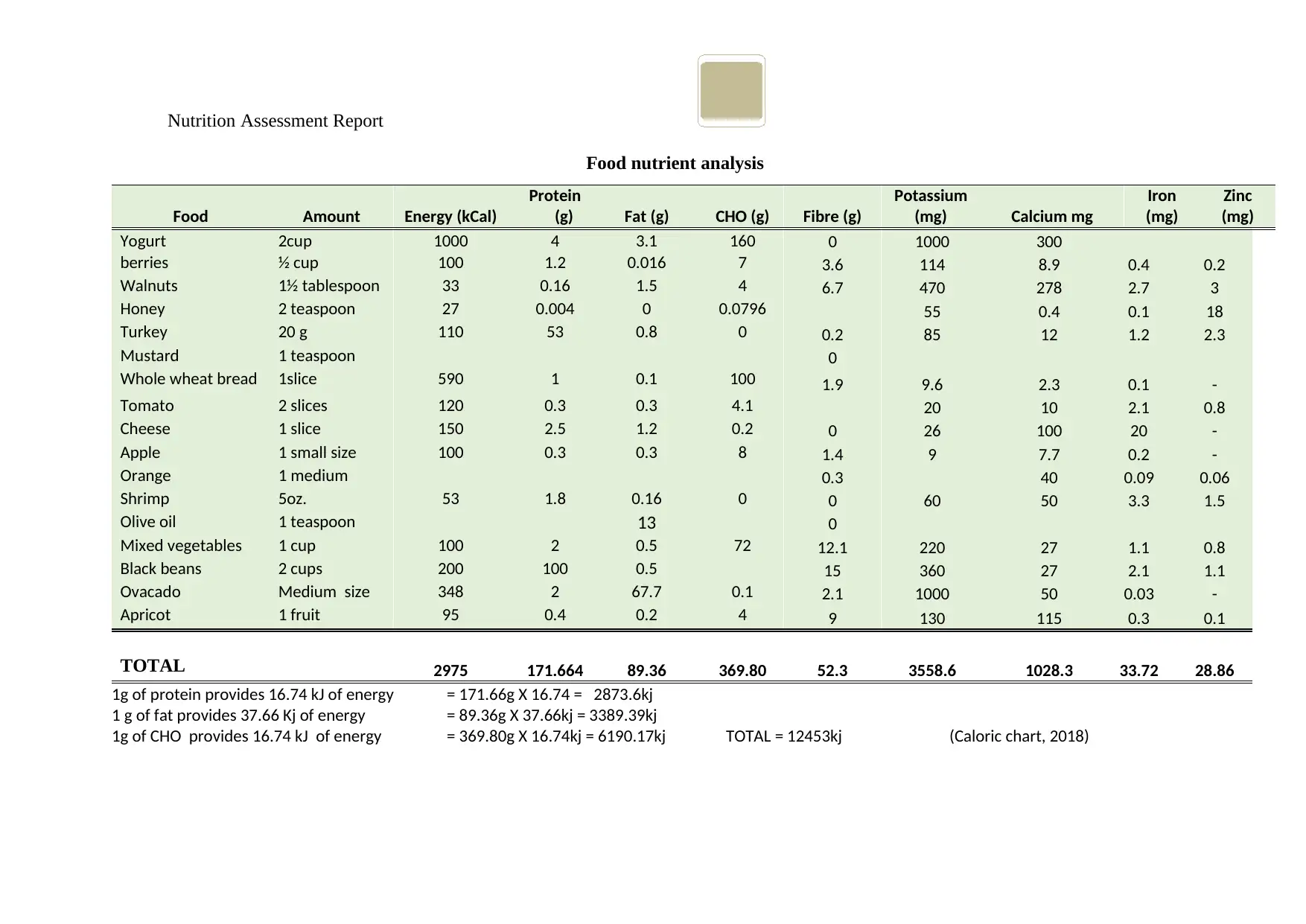
Nutrition Assessment Report
Food nutrient analysis
Food Amount Energy (kCal)
Protein
(g) Fat (g) CHO (g) Fibre (g)
Potassium
(mg) Calcium mg
Iron
(mg)
Zinc
(mg)
Yogurt 2cup 1000 4 3.1 160 0 1000 300
berries ½ cup 100 1.2 0.016 7 3.6 114 8.9 0.4 0.2
Walnuts 1½ tablespoon 33 0.16 1.5 4 6.7 470 278 2.7 3
Honey 2 teaspoon 27 0.004 0 0.0796 55 0.4 0.1 18
Turkey 20 g 110 53 0.8 0 0.2 85 12 1.2 2.3
Mustard 1 teaspoon 0
Whole wheat bread 1slice 590 1 0.1 100 1.9 9.6 2.3 0.1 -
Tomato 2 slices 120 0.3 0.3 4.1 20 10 2.1 0.8
Cheese 1 slice 150 2.5 1.2 0.2 0 26 100 20 -
Apple 1 small size 100 0.3 0.3 8 1.4 9 7.7 0.2 -
Orange 1 medium 0.3 40 0.09 0.06
Shrimp 5oz. 53 1.8 0.16 0 0 60 50 3.3 1.5
Olive oil 1 teaspoon 13 0
Mixed vegetables 1 cup 100 2 0.5 72 12.1 220 27 1.1 0.8
Black beans 2 cups 200 100 0.5 15 360 27 2.1 1.1
Ovacado Medium size 348 2 67.7 0.1 2.1 1000 50 0.03 -
Apricot 1 fruit 95 0.4 0.2 4 9 130 115 0.3 0.1
TOTAL 2975 171.664 89.36 369.80 52.3 3558.6 1028.3 33.72 28.86
1g of protein provides 16.74 kJ of energy = 171.66g X 16.74 = 2873.6kj
1 g of fat provides 37.66 Kj of energy = 89.36g X 37.66kj = 3389.39kj
1g of CHO provides 16.74 kJ of energy = 369.80g X 16.74kj = 6190.17kj TOTAL = 12453kj (Caloric chart, 2018)
Food nutrient analysis
Food Amount Energy (kCal)
Protein
(g) Fat (g) CHO (g) Fibre (g)
Potassium
(mg) Calcium mg
Iron
(mg)
Zinc
(mg)
Yogurt 2cup 1000 4 3.1 160 0 1000 300
berries ½ cup 100 1.2 0.016 7 3.6 114 8.9 0.4 0.2
Walnuts 1½ tablespoon 33 0.16 1.5 4 6.7 470 278 2.7 3
Honey 2 teaspoon 27 0.004 0 0.0796 55 0.4 0.1 18
Turkey 20 g 110 53 0.8 0 0.2 85 12 1.2 2.3
Mustard 1 teaspoon 0
Whole wheat bread 1slice 590 1 0.1 100 1.9 9.6 2.3 0.1 -
Tomato 2 slices 120 0.3 0.3 4.1 20 10 2.1 0.8
Cheese 1 slice 150 2.5 1.2 0.2 0 26 100 20 -
Apple 1 small size 100 0.3 0.3 8 1.4 9 7.7 0.2 -
Orange 1 medium 0.3 40 0.09 0.06
Shrimp 5oz. 53 1.8 0.16 0 0 60 50 3.3 1.5
Olive oil 1 teaspoon 13 0
Mixed vegetables 1 cup 100 2 0.5 72 12.1 220 27 1.1 0.8
Black beans 2 cups 200 100 0.5 15 360 27 2.1 1.1
Ovacado Medium size 348 2 67.7 0.1 2.1 1000 50 0.03 -
Apricot 1 fruit 95 0.4 0.2 4 9 130 115 0.3 0.1
TOTAL 2975 171.664 89.36 369.80 52.3 3558.6 1028.3 33.72 28.86
1g of protein provides 16.74 kJ of energy = 171.66g X 16.74 = 2873.6kj
1 g of fat provides 37.66 Kj of energy = 89.36g X 37.66kj = 3389.39kj
1g of CHO provides 16.74 kJ of energy = 369.80g X 16.74kj = 6190.17kj TOTAL = 12453kj (Caloric chart, 2018)
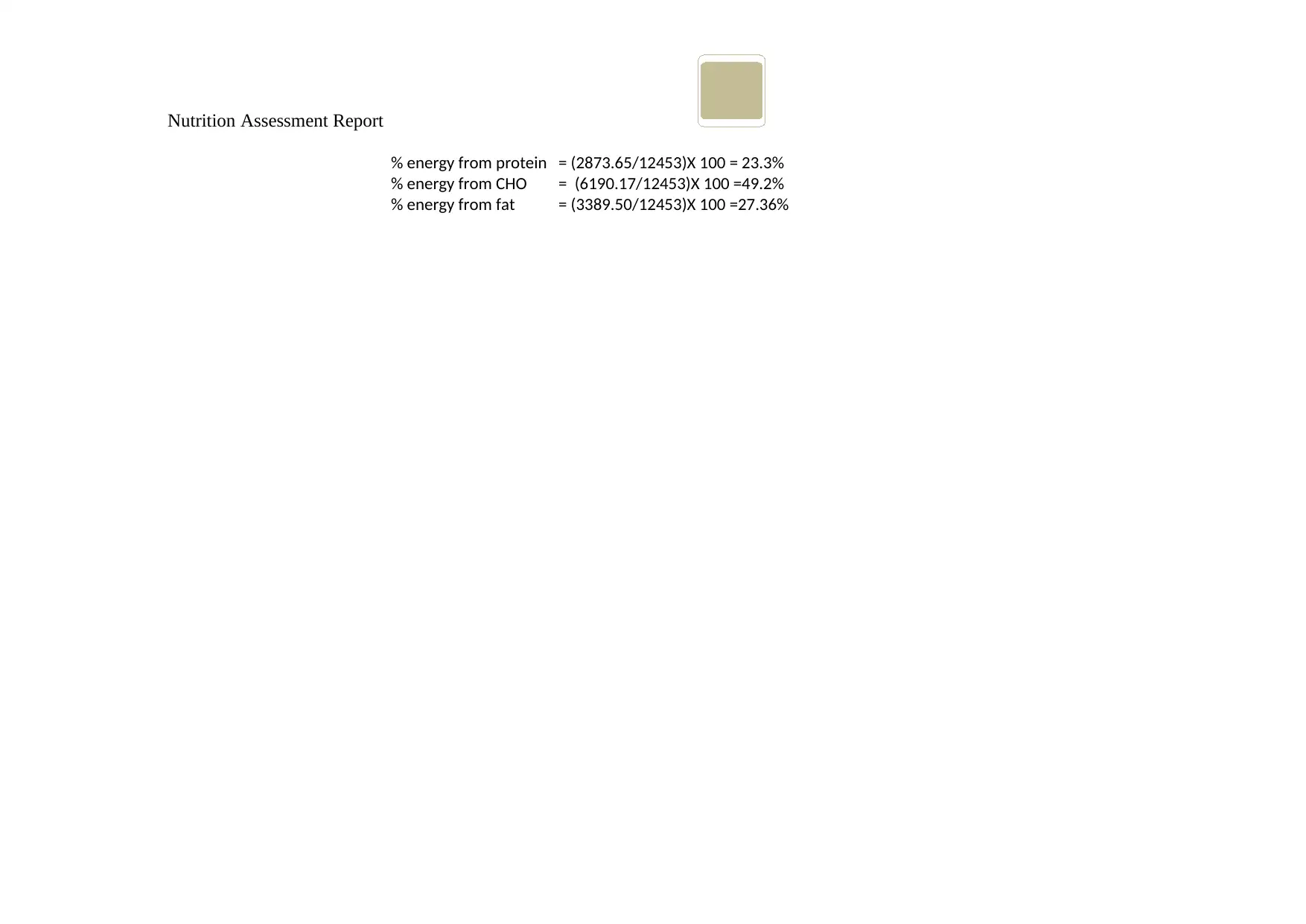
Nutrition Assessment Report
% energy from protein = (2873.65/12453)X 100 = 23.3%
% energy from CHO = (6190.17/12453)X 100 =49.2%
% energy from fat = (3389.50/12453)X 100 =27.36%
% energy from protein = (2873.65/12453)X 100 = 23.3%
% energy from CHO = (6190.17/12453)X 100 =49.2%
% energy from fat = (3389.50/12453)X 100 =27.36%
⊘ This is a preview!⊘
Do you want full access?
Subscribe today to unlock all pages.

Trusted by 1+ million students worldwide
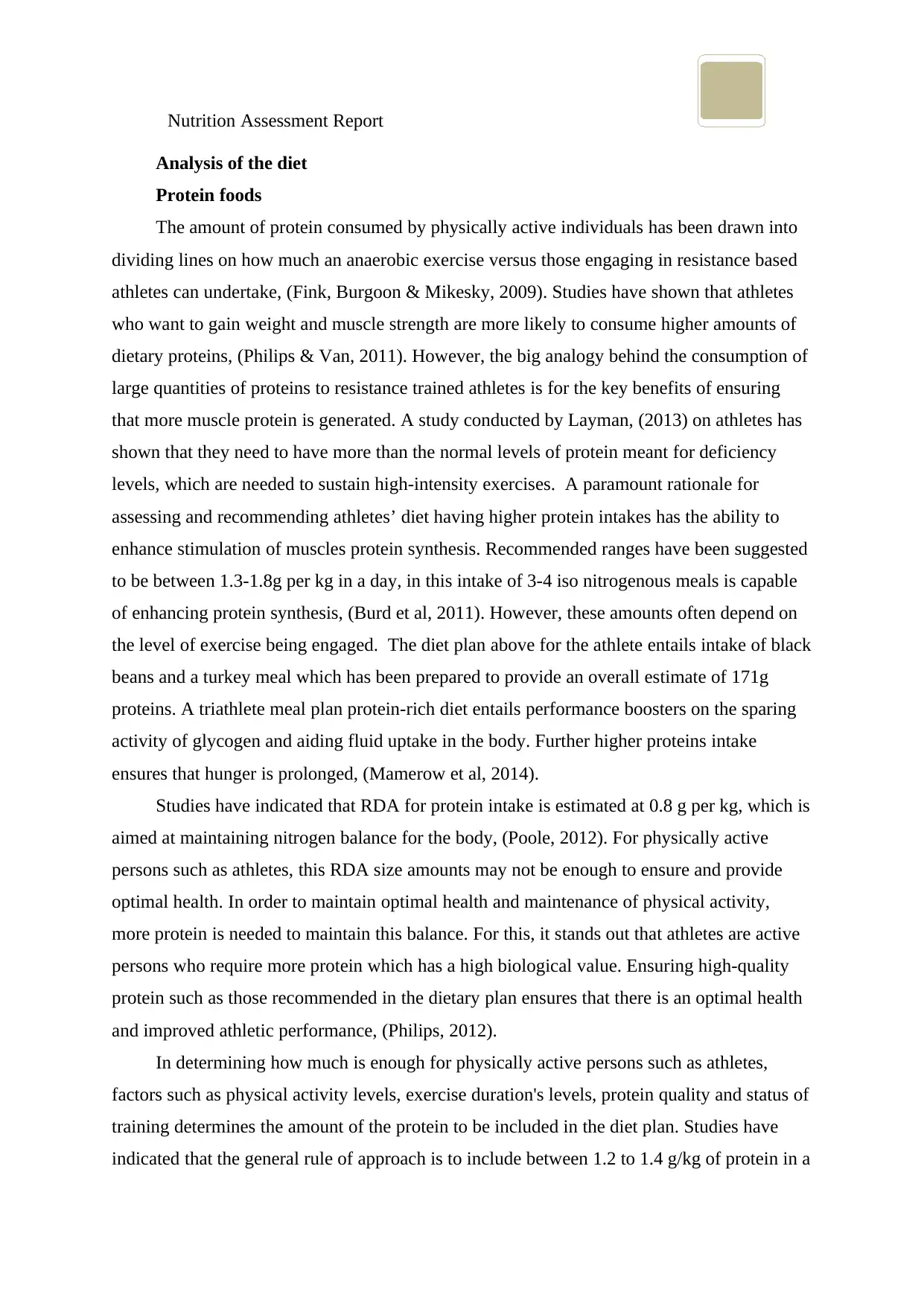
Nutrition Assessment Report
Analysis of the diet
Protein foods
The amount of protein consumed by physically active individuals has been drawn into
dividing lines on how much an anaerobic exercise versus those engaging in resistance based
athletes can undertake, (Fink, Burgoon & Mikesky, 2009). Studies have shown that athletes
who want to gain weight and muscle strength are more likely to consume higher amounts of
dietary proteins, (Philips & Van, 2011). However, the big analogy behind the consumption of
large quantities of proteins to resistance trained athletes is for the key benefits of ensuring
that more muscle protein is generated. A study conducted by Layman, (2013) on athletes has
shown that they need to have more than the normal levels of protein meant for deficiency
levels, which are needed to sustain high-intensity exercises. A paramount rationale for
assessing and recommending athletes’ diet having higher protein intakes has the ability to
enhance stimulation of muscles protein synthesis. Recommended ranges have been suggested
to be between 1.3-1.8g per kg in a day, in this intake of 3-4 iso nitrogenous meals is capable
of enhancing protein synthesis, (Burd et al, 2011). However, these amounts often depend on
the level of exercise being engaged. The diet plan above for the athlete entails intake of black
beans and a turkey meal which has been prepared to provide an overall estimate of 171g
proteins. A triathlete meal plan protein-rich diet entails performance boosters on the sparing
activity of glycogen and aiding fluid uptake in the body. Further higher proteins intake
ensures that hunger is prolonged, (Mamerow et al, 2014).
Studies have indicated that RDA for protein intake is estimated at 0.8 g per kg, which is
aimed at maintaining nitrogen balance for the body, (Poole, 2012). For physically active
persons such as athletes, this RDA size amounts may not be enough to ensure and provide
optimal health. In order to maintain optimal health and maintenance of physical activity,
more protein is needed to maintain this balance. For this, it stands out that athletes are active
persons who require more protein which has a high biological value. Ensuring high-quality
protein such as those recommended in the dietary plan ensures that there is an optimal health
and improved athletic performance, (Philips, 2012).
In determining how much is enough for physically active persons such as athletes,
factors such as physical activity levels, exercise duration's levels, protein quality and status of
training determines the amount of the protein to be included in the diet plan. Studies have
indicated that the general rule of approach is to include between 1.2 to 1.4 g/kg of protein in a
Analysis of the diet
Protein foods
The amount of protein consumed by physically active individuals has been drawn into
dividing lines on how much an anaerobic exercise versus those engaging in resistance based
athletes can undertake, (Fink, Burgoon & Mikesky, 2009). Studies have shown that athletes
who want to gain weight and muscle strength are more likely to consume higher amounts of
dietary proteins, (Philips & Van, 2011). However, the big analogy behind the consumption of
large quantities of proteins to resistance trained athletes is for the key benefits of ensuring
that more muscle protein is generated. A study conducted by Layman, (2013) on athletes has
shown that they need to have more than the normal levels of protein meant for deficiency
levels, which are needed to sustain high-intensity exercises. A paramount rationale for
assessing and recommending athletes’ diet having higher protein intakes has the ability to
enhance stimulation of muscles protein synthesis. Recommended ranges have been suggested
to be between 1.3-1.8g per kg in a day, in this intake of 3-4 iso nitrogenous meals is capable
of enhancing protein synthesis, (Burd et al, 2011). However, these amounts often depend on
the level of exercise being engaged. The diet plan above for the athlete entails intake of black
beans and a turkey meal which has been prepared to provide an overall estimate of 171g
proteins. A triathlete meal plan protein-rich diet entails performance boosters on the sparing
activity of glycogen and aiding fluid uptake in the body. Further higher proteins intake
ensures that hunger is prolonged, (Mamerow et al, 2014).
Studies have indicated that RDA for protein intake is estimated at 0.8 g per kg, which is
aimed at maintaining nitrogen balance for the body, (Poole, 2012). For physically active
persons such as athletes, this RDA size amounts may not be enough to ensure and provide
optimal health. In order to maintain optimal health and maintenance of physical activity,
more protein is needed to maintain this balance. For this, it stands out that athletes are active
persons who require more protein which has a high biological value. Ensuring high-quality
protein such as those recommended in the dietary plan ensures that there is an optimal health
and improved athletic performance, (Philips, 2012).
In determining how much is enough for physically active persons such as athletes,
factors such as physical activity levels, exercise duration's levels, protein quality and status of
training determines the amount of the protein to be included in the diet plan. Studies have
indicated that the general rule of approach is to include between 1.2 to 1.4 g/kg of protein in a
Paraphrase This Document
Need a fresh take? Get an instant paraphrase of this document with our AI Paraphraser

Nutrition Assessment Report
day for endurance athletes who include the triathlete case study, (Colombani & Mettler,
2011). The longer the duration of exercise training, the greater the number of proteins spent.
Other research undertaken have recommended up to 2g/kg of body weight for athletes who
engage in long duration exercises and having high physical activity levels. Increase in
physical exercises is directly proportional to the number of proteins being consumed. It is for
this reason that the diet plan above accumulates to a total of 179g being consumed by the
athlete based on a 2g/kg body weight. Compared to endurance training, single training
sessions and shorter excurse durations have been shown not to need more proteins intake,
(Mettler, Mitchell & Tipton, 2010).
The types of proteins consumed have a factor on bioavailability, in all essential amino
acids; leucine has been shown to have a limiting factor on proteins bioavailability. Leucine-
rich foods have been shown to have an effect on boosting muscle proteins. Including a
mixture of proteins in diet such as above mixing plant and animal based diet is essential as
they are rich in essential amino acids essential for muscle protein synthesis, (Helms, Zinn,
Rowlands & Brown, 2014).
Carbohydrate foods
Intake of carbohydrates is linked to improved endurance levels which are key to high-
intensity exercises, athletes and cyclists have been shown to experience high performance
and high outputs after high intake of carbohydrates, (Bartlett, Hawley & Morton, 2015). The
intake of carbohydrates among athletes such as Mark is geared to towards performance in
training. This key component is vital in order to maximize and optimize performance
recovery process.an assessment by Burke et al, (2010), showed that low glycogen for athletes
and long endurance sports persons yields muscle fatigue and the inability of the body to
enhance high-intensity exercise. Both levels of exercises such as aerobic and anaerobic have
been shown to deplete exercise glycogen stores in the body.
Carbohydrate for exercise performance has been investigated and studies and results
have great key influencing sports nutrition. Carbohydrate recommendation of about 6-10
g/kg body weight has been recommended for high-performance athletes based on the duration
of exercise, training, and physical activity levels, (Cermak & van Loon, 2013). For the
athlete, the diet provides a total of 50% carbohydrates with 369 g of carbohydrates based on
the level of physical activity and body weight. Consumption proportion to the number of
servings varies in the athlete in that the number servings illustrated is able to provide the
day for endurance athletes who include the triathlete case study, (Colombani & Mettler,
2011). The longer the duration of exercise training, the greater the number of proteins spent.
Other research undertaken have recommended up to 2g/kg of body weight for athletes who
engage in long duration exercises and having high physical activity levels. Increase in
physical exercises is directly proportional to the number of proteins being consumed. It is for
this reason that the diet plan above accumulates to a total of 179g being consumed by the
athlete based on a 2g/kg body weight. Compared to endurance training, single training
sessions and shorter excurse durations have been shown not to need more proteins intake,
(Mettler, Mitchell & Tipton, 2010).
The types of proteins consumed have a factor on bioavailability, in all essential amino
acids; leucine has been shown to have a limiting factor on proteins bioavailability. Leucine-
rich foods have been shown to have an effect on boosting muscle proteins. Including a
mixture of proteins in diet such as above mixing plant and animal based diet is essential as
they are rich in essential amino acids essential for muscle protein synthesis, (Helms, Zinn,
Rowlands & Brown, 2014).
Carbohydrate foods
Intake of carbohydrates is linked to improved endurance levels which are key to high-
intensity exercises, athletes and cyclists have been shown to experience high performance
and high outputs after high intake of carbohydrates, (Bartlett, Hawley & Morton, 2015). The
intake of carbohydrates among athletes such as Mark is geared to towards performance in
training. This key component is vital in order to maximize and optimize performance
recovery process.an assessment by Burke et al, (2010), showed that low glycogen for athletes
and long endurance sports persons yields muscle fatigue and the inability of the body to
enhance high-intensity exercise. Both levels of exercises such as aerobic and anaerobic have
been shown to deplete exercise glycogen stores in the body.
Carbohydrate for exercise performance has been investigated and studies and results
have great key influencing sports nutrition. Carbohydrate recommendation of about 6-10
g/kg body weight has been recommended for high-performance athletes based on the duration
of exercise, training, and physical activity levels, (Cermak & van Loon, 2013). For the
athlete, the diet provides a total of 50% carbohydrates with 369 g of carbohydrates based on
the level of physical activity and body weight. Consumption proportion to the number of
servings varies in the athlete in that the number servings illustrated is able to provide the
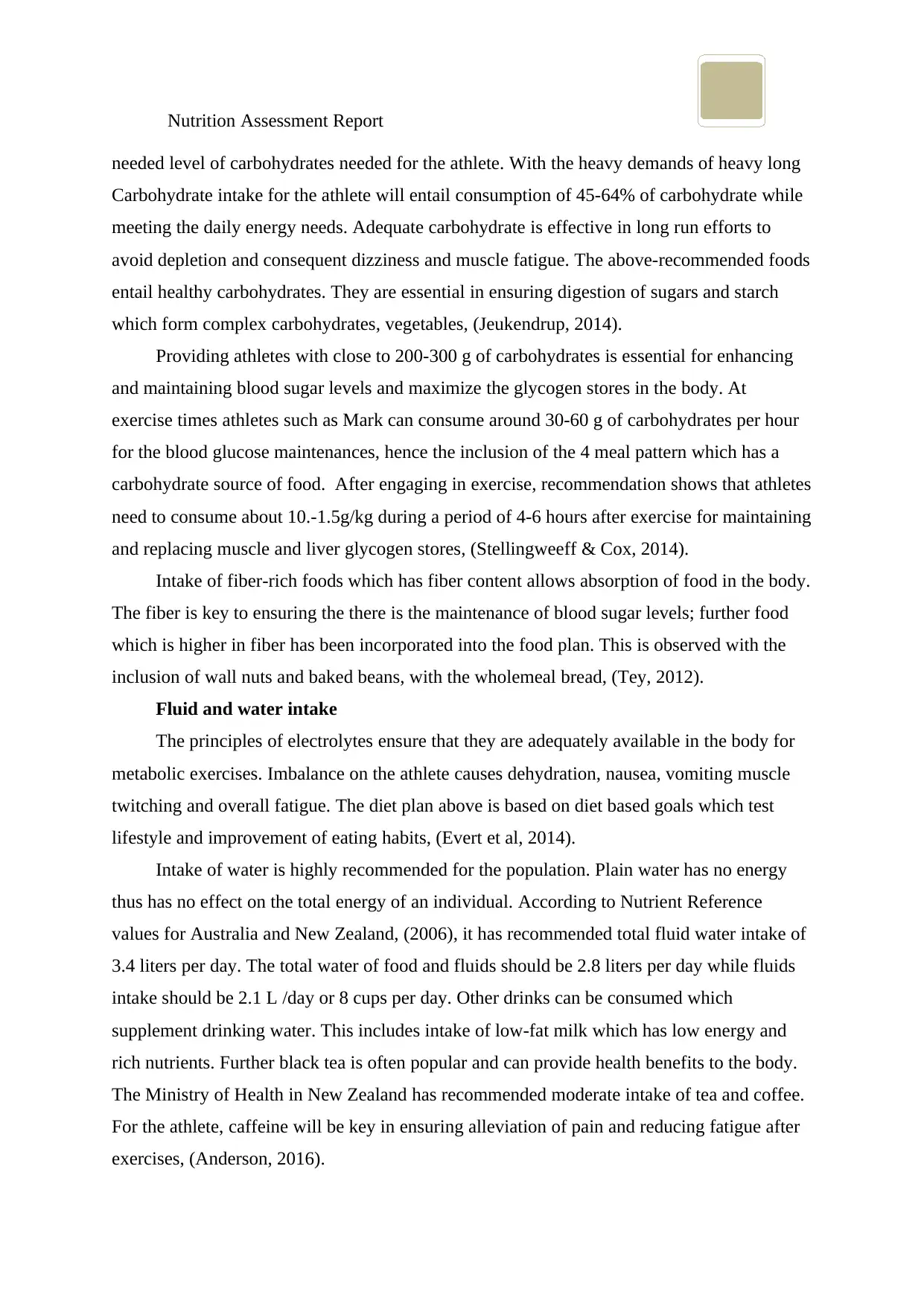
Nutrition Assessment Report
needed level of carbohydrates needed for the athlete. With the heavy demands of heavy long
Carbohydrate intake for the athlete will entail consumption of 45-64% of carbohydrate while
meeting the daily energy needs. Adequate carbohydrate is effective in long run efforts to
avoid depletion and consequent dizziness and muscle fatigue. The above-recommended foods
entail healthy carbohydrates. They are essential in ensuring digestion of sugars and starch
which form complex carbohydrates, vegetables, (Jeukendrup, 2014).
Providing athletes with close to 200-300 g of carbohydrates is essential for enhancing
and maintaining blood sugar levels and maximize the glycogen stores in the body. At
exercise times athletes such as Mark can consume around 30-60 g of carbohydrates per hour
for the blood glucose maintenances, hence the inclusion of the 4 meal pattern which has a
carbohydrate source of food. After engaging in exercise, recommendation shows that athletes
need to consume about 10.-1.5g/kg during a period of 4-6 hours after exercise for maintaining
and replacing muscle and liver glycogen stores, (Stellingweeff & Cox, 2014).
Intake of fiber-rich foods which has fiber content allows absorption of food in the body.
The fiber is key to ensuring the there is the maintenance of blood sugar levels; further food
which is higher in fiber has been incorporated into the food plan. This is observed with the
inclusion of wall nuts and baked beans, with the wholemeal bread, (Tey, 2012).
Fluid and water intake
The principles of electrolytes ensure that they are adequately available in the body for
metabolic exercises. Imbalance on the athlete causes dehydration, nausea, vomiting muscle
twitching and overall fatigue. The diet plan above is based on diet based goals which test
lifestyle and improvement of eating habits, (Evert et al, 2014).
Intake of water is highly recommended for the population. Plain water has no energy
thus has no effect on the total energy of an individual. According to Nutrient Reference
values for Australia and New Zealand, (2006), it has recommended total fluid water intake of
3.4 liters per day. The total water of food and fluids should be 2.8 liters per day while fluids
intake should be 2.1 L /day or 8 cups per day. Other drinks can be consumed which
supplement drinking water. This includes intake of low-fat milk which has low energy and
rich nutrients. Further black tea is often popular and can provide health benefits to the body.
The Ministry of Health in New Zealand has recommended moderate intake of tea and coffee.
For the athlete, caffeine will be key in ensuring alleviation of pain and reducing fatigue after
exercises, (Anderson, 2016).
needed level of carbohydrates needed for the athlete. With the heavy demands of heavy long
Carbohydrate intake for the athlete will entail consumption of 45-64% of carbohydrate while
meeting the daily energy needs. Adequate carbohydrate is effective in long run efforts to
avoid depletion and consequent dizziness and muscle fatigue. The above-recommended foods
entail healthy carbohydrates. They are essential in ensuring digestion of sugars and starch
which form complex carbohydrates, vegetables, (Jeukendrup, 2014).
Providing athletes with close to 200-300 g of carbohydrates is essential for enhancing
and maintaining blood sugar levels and maximize the glycogen stores in the body. At
exercise times athletes such as Mark can consume around 30-60 g of carbohydrates per hour
for the blood glucose maintenances, hence the inclusion of the 4 meal pattern which has a
carbohydrate source of food. After engaging in exercise, recommendation shows that athletes
need to consume about 10.-1.5g/kg during a period of 4-6 hours after exercise for maintaining
and replacing muscle and liver glycogen stores, (Stellingweeff & Cox, 2014).
Intake of fiber-rich foods which has fiber content allows absorption of food in the body.
The fiber is key to ensuring the there is the maintenance of blood sugar levels; further food
which is higher in fiber has been incorporated into the food plan. This is observed with the
inclusion of wall nuts and baked beans, with the wholemeal bread, (Tey, 2012).
Fluid and water intake
The principles of electrolytes ensure that they are adequately available in the body for
metabolic exercises. Imbalance on the athlete causes dehydration, nausea, vomiting muscle
twitching and overall fatigue. The diet plan above is based on diet based goals which test
lifestyle and improvement of eating habits, (Evert et al, 2014).
Intake of water is highly recommended for the population. Plain water has no energy
thus has no effect on the total energy of an individual. According to Nutrient Reference
values for Australia and New Zealand, (2006), it has recommended total fluid water intake of
3.4 liters per day. The total water of food and fluids should be 2.8 liters per day while fluids
intake should be 2.1 L /day or 8 cups per day. Other drinks can be consumed which
supplement drinking water. This includes intake of low-fat milk which has low energy and
rich nutrients. Further black tea is often popular and can provide health benefits to the body.
The Ministry of Health in New Zealand has recommended moderate intake of tea and coffee.
For the athlete, caffeine will be key in ensuring alleviation of pain and reducing fatigue after
exercises, (Anderson, 2016).
⊘ This is a preview!⊘
Do you want full access?
Subscribe today to unlock all pages.

Trusted by 1+ million students worldwide
1 out of 21
Related Documents
Your All-in-One AI-Powered Toolkit for Academic Success.
+13062052269
info@desklib.com
Available 24*7 on WhatsApp / Email
![[object Object]](/_next/static/media/star-bottom.7253800d.svg)
Unlock your academic potential
Copyright © 2020–2025 A2Z Services. All Rights Reserved. Developed and managed by ZUCOL.





